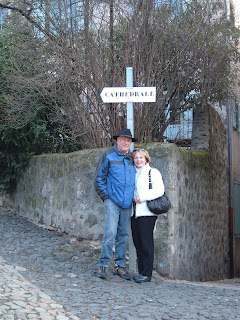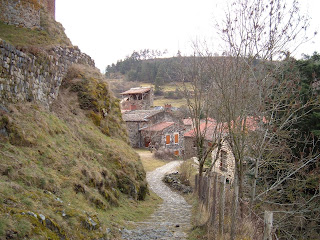The fortified church has massive crenellated exterior walls surmounted by a keep-like structure on the upper chapel. It is the gateway to the Camargue and Provence much to the delight of plunders who used it as a bridgehead. In the event of a seige, the church not only protected the relics of the two Saint Maries and Saint Sarah which it housed, but also the local population. A freshwater well inside the church allowed the people to survive under seige.
The comments and photos in this blog reflect those of Diane Glasmann and in no way represent AED, Fulbright Commission or the Department of State of the U.S. Government.
Thursday, March 31, 2011
Week-end to Provence- La Camargue: Saintes Maries de la Mer and Aigues Mortes (Day 2)
The village of Saintes Maries de la Mer is famous for its fortified church and as a place of great pilgrimage. According to Provençal legend, in 40AD, Marie Jocobé, Marie Salomé and their slave Sarah were chased from Jerusalem and abandoned to the waves in a boat without the aid of a sail or oars. They survived and arrived at the shore of the Camargue. Many years later, the area became a pilgrimage site and Gypsies from afar developed a special veneration for Sarah. A vast Gypsy Celebration is held each year on May 24 and 25 dating back to the Middle Ages.
The fortified church has massive crenellated exterior walls surmounted by a keep-like structure on the upper chapel. It is the gateway to the Camargue and Provence much to the delight of plunders who used it as a bridgehead. In the event of a seige, the church not only protected the relics of the two Saint Maries and Saint Sarah which it housed, but also the local population. A freshwater well inside the church allowed the people to survive under seige.
We really enjoyed driving around the Camargue as it is also a beautiful nature reserve where birds, especially flamingos, abound. Camargue wild and semi wild horses are easily seen grazing in the marshes. We continued on to Aigues-Mortes, a fortified city with 13th century ramparts. The town was develped in 1240 by Louis IX, St. Louis, who was preparing to set out on a crusade to liberate Jerusalem. At this time France was not unified and did not possess a Mediterranean seaport. A local monastery hearing of his intended voyage, presented him with a small fishing village at the end of an isthmus known as Dead or Still Waters-Aigues Mortes. The King constructed the Constance Tower to defend the harbor. In 1248 Louis set sail with a fleet of 38 ships on the Seventh Crusade. After a long campaign in Egypt and a second in Palestine, but both unsuccessful, he returned to France. He set out again from Aigues-Mortes in 1270 for Tunis on the Eighth Crusade where he died of the plague.
The fortified church has massive crenellated exterior walls surmounted by a keep-like structure on the upper chapel. It is the gateway to the Camargue and Provence much to the delight of plunders who used it as a bridgehead. In the event of a seige, the church not only protected the relics of the two Saint Maries and Saint Sarah which it housed, but also the local population. A freshwater well inside the church allowed the people to survive under seige.
Tuesday, March 29, 2011
Week-end to Provence: Nimes and Roman Ruins! (Day 1)
We ventured out very early Saturday morning driving south towards our destination of Les Saintes Maries de la Mer. We stopped along the way to see the majestic Pont du Gard; an impressive sight since it was built nearly 2000 years age! The aqueduct was constructed by Agrippa in 19BC to carry water of the Eure near Uzès to Nimes, about 25 miles away.
A Wednesday Excursion to Mont Mézenc and Les Estables!
I headed south for a change of scenery to see Mont Mézenc (only 30 miles away although it took an hour to drive there). The volcanic Mézenc range forms a natural barrier that divides the rivers flowing to the Atlantic from those flowing to the Mediterranean. The Mont Mézenc rises to 5,751 feet which gives its name to the whole range. This area saw the first creaters during the Tertiary Era, though they are no longer recognizable. Later eruptions led to the formation to the great planèzes on the eastern slopes followed by huge phonolithic cones. The Quaternary Era brought the extention of the glaciers and the last eruptions filled in the valley with thick flows of basalt. On the Valey side of the Mézenc massif the range looks like a vast, barren plateau dotted with low farmhouses and barns displaying thatched or stone slab roofs.
I drove further to Les Estables, a small mountain village lying at the foothills of the Mézenc. It is a popular winter ski area offering both cross country skiing and a few T-bar lifts for Alpine skiing.
I drove further to Les Estables, a small mountain village lying at the foothills of the Mézenc. It is a popular winter ski area offering both cross country skiing and a few T-bar lifts for Alpine skiing.
A Week-End Visit with Sally and Lee!
Sally and Lee drove from Chambéry in the French Alps to visit me on March 19. We spent the day visiting my near-by "must see" city. We strolled down the narrow streets of the old quarter, had lunch in one of my favorite restaurants in Puy called La Taverne de Maître Kanter and then hiked up to the beautiful Romanesque church, Cathédrale Notre Dame de Puy. The church is now a UNESCO World Heritage Site and owes its appearance to the influence of the Orient; the Byzantine details are a result of the crusades. The church is built of polychrome lava and balanced atop the a narrow pinnacle, reachable only by a long flight of steps. The steps lead to the main door under the four bays built in the 12 century. At the level of the second bay, two 12C doors close off two side chapels: their faint decoration in relief recounts the life of Christ. In the Middle Ages, pilgrimages to Le Puy were popular since it was a departure point for pilgrimages to Santiago de Compostela in Spain. Along, with Chartres, Le Puy is the oldest site of Marian worship in France.
Sunday, March 20, 2011
Winter Wedding in Vermont!
Wednesday excursion to Arlempedes in the Auvergne
Skiing in Mégève!
Subscribe to:
Posts (Atom)





























